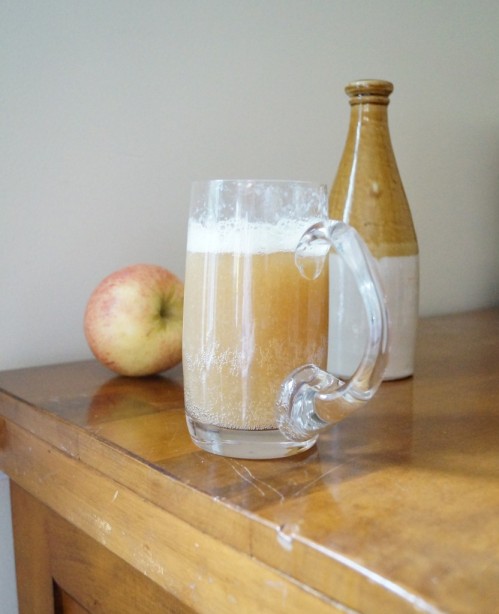
Thoughts:
The basic idea of this beer is that it uses apple cider instead of water in the wort. It ended up quirky, in that at least half the fermenting beer was sediment in the jug. I ended up making a great bread from that sediment, and a variety of other recipes from the spent grains. In that sense, it’s a winning brew, because it’s so versatile, but I think the brew itself needs a bit more work still.
The taste of this is… unusual. The apple elements are there, which made me expect it to be sweet. But it’s a beer, so it’s decidedly beery. It pours out very fizzy, but the head doesn’t last long. As it sits, a layer of malt sediment settles to the bottom of the glass. It has a sour element and a slightly thick consistency.
I wonder about what could be added to this: vanilla, cinnamon, ginger, etc.
Proposed Location?
Anywhere with an abundance of apples, so probably either in the Reach or the North.
Recipe for Colonial Apple Beer
“stamp apels and strain them as usuly for Cyder, then take the Liquor and warm it and put it upon the malt, then when it is Com throu boyle it, and then worke it Like other bere, when it is put into vesells put 3 pound of hard suger in to the quantity of an hogsheed, a few hops should be boyled in it.” -Penn Family Recipes, 1674
Ingredients:
- 1 gallon cider
- 2.5 lb. light malt mix
- 6 cups boiling water (for sparge)
- .2 oz. hops, at 15 minutes to end of boil
- 1 tsp. Irish Moss (optional) at 15 minutes to end of boil
- yeast
- .06 lb. sugar to prime
Heat cider to about 150F, and add the malt, preferably in a straining bag. Soak the grains at the temperature for 45-60 minutes, then remove, squeezing to extract as much liquid as possible.
Sparge with 6 cups boiling water, and squeeze again to remove liquid. Reserve the spent grains for baking.
Boil the liquid for 30 minutes or so, adding in the hops and the Irish moss near the end. Strain and let cool, then pour into your carboy. When cooled, pitch the yeast and cap with an airlock.
In addition to baking a quirky cool beer, the cast offs from the brew can be used to make a variety of tasty foods:
- Apple Beer Trub Bread
- Apple Barley Pudding, with whiskey cream
- Maple Oatmeal Scones


Huh! I recently tried making a cyser and ended up with a similar tall, fluffy sediment with chimneys in it. It smelled kinda funny and I didn’t like the taste, so ended up pouring it out. What sort of cider did you use?
Just your average fresh pressed murky brown stuff. I’m in New England, so it’s everywhere.
I will probably try it again, as it definitely has potential.
Whenever I make a pumpkin ale, I always end up with significantly more sediment in the fermenter. Scientifically, the same thing might be happening to cause that with apple cider…what that would be, though, I have no idea.
I’m surprised the sediment was good for cooking…I don’t think that from a more traditional batch of beer would be.
Something somewhat similar to this that I am aware of is to use pure maple sap in place of water. That might be worth trying for a Westerosi recipe sometime as well.
Either way, this is a very cool idea, certainly a real apple ale, unlike that thing they’ve been advertising on TV recently 😉
Oh, I’m going to dream about that maple sap for a while. It’ll probably be a few years before I can move anywhere with my own trees, though.
Did you try clearing the racked beer with an egg white? It sounds like it might help the sediment in the glass problem.
I’ve used the egg white trick with mead, but in those cases, the white is usually boiled with the wort at the beginning. How would you suggest using it with this beer?
Try adding an egg white to the beer after racking. Beat the white slightly and then dump it into the demijohn. Agitate to mix and leave it for a few days, then rack again. With wines, it works quite well to clear them if there is a still a lot of sediment in suspension. No cooking required.
How long did you let it ferment?
I let it ferment about a week the two times I’ve done this recipe. It is really refreshing in the summer, but is a definite brewzilla. I just got 23litres of fresh pressed cider from a local orchard to make a full sized batch.
Recently I’ve done a lot of reading about less popular/forgotten styles of brewed beverages. That’s why I’m here:-) One of the things I came across was a cider/beer hybrid called Graf. Graf is a fictional beverage in the Steven King “Dark Tower” series that has a decent fan base in the beer homebrewing community. There are lots of homebrewers making it in all manner of different ratios of cider to wort and styles of the base beer. Really interesting stuff with hours of reading if you’re into doing some Google-Fu.
My point is, after that long-winded intro, is that I thought surely someone had thought of this combination before now. I looked for recipes that predate the fictional mention of Graf, but couldn’t find any. It seems the homebrewing community by and large is unaware of this early recipe.
Thanks so much for highlighting this historical recipe and testing it out for us:) Love this blog, and I love my Feast of Ice and Fire cookbook!